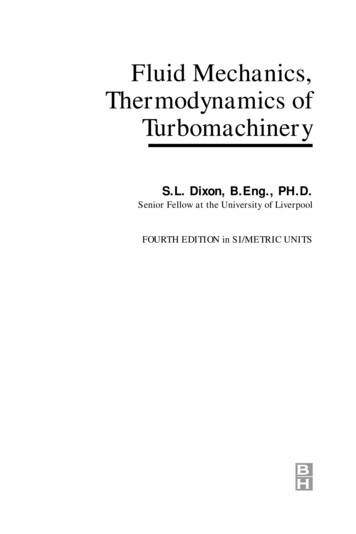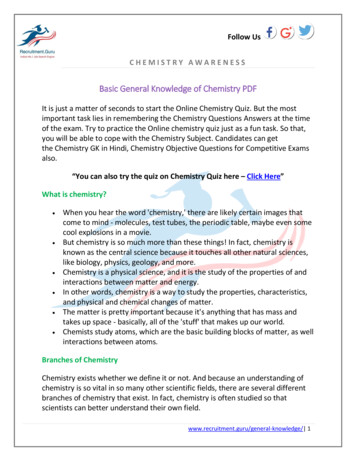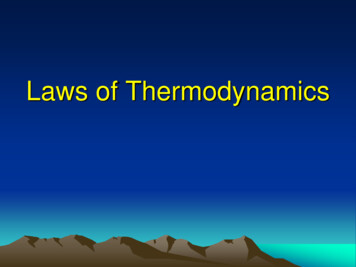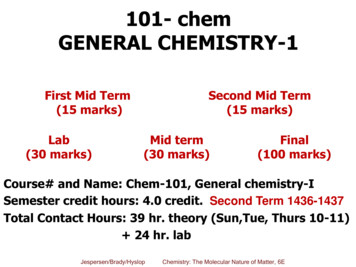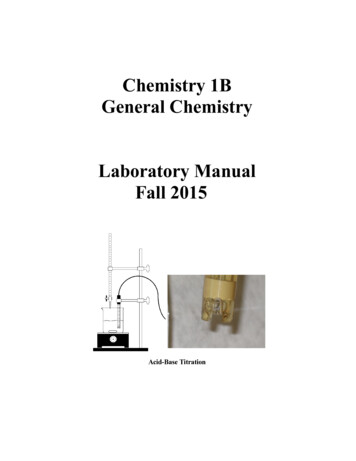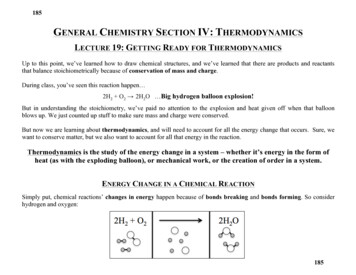
Transcription
185GENERAL CHEMISTRY SECTION IV: THERMODYNAMICSLECTURE 19: GETTING READY FOR THERMODYNAMICSUp to this point, we’ve learned how to draw chemical structures, and we’ve learned that there are products and reactantsthat balance stoichiometrically because of conservation of mass and charge.During class, you’ve seen this reaction happen 2H2 O2 2H2O Big hydrogen balloon explosion!But in understanding the stoichiometry, we’ve paid no attention to the explosion and heat given off when that balloonblows up. We just counted up stuff to make sure mass and charge were conserved.But now we are learning about thermodynamics, and will need to account for all the energy change that occurs. Sure, wewant to conserve matter, but we also want to account for all that energy in the reaction.Thermodynamics is the study of the energy change in a system – whether it’s energy in the form ofheat (as with the exploding balloon), or mechanical work, or the creation of order in a system.ENERGY CHANGE IN A CHEMICAL REACTIONSimply put, chemical reactions’ changes in energy happen because of bonds breaking and bonds forming. So considerhydrogen and oxygen:185
186This E is what we study, and we’ll end up seeing that there are a variety of energy-related changes for us to measure aswe work our way through thermodynamics:ΔGΔHΔEFree energyEnthalpyInternal energyΔSEntropywqWorkHeatOUR PLAYGROUND FOR THERMODYNAMICS: UNIVERSE, SYSTEM, AND SURROUNDINGSBefore starting thermo, we need to define our territory:We are in a universe (which is everything).But we are only concerned with the system (which, in chemistry, is the chemical reaction).And we like to isolate the chemical reaction/system by putting it in a closed environment; everything outside ofthat closed environment is the surroundings.Universe System Surroundings186
187Many of the properties of systems that we’re interested in are called state functions – properties of a system about whichwe care only the starting and ending states/values. Some of these we’ve already learned about in the context of gases:Temperature (T)Pressure (P)Volume (V)Moles (n)And we’ll learn about a few more in the coming thermo lectures:Internal energy (E or U)Enthalpy (H)Entropy (S)Gibbs free energy (G)Here’s another way to think of state functions: any information about what happened to a state function during the reactionis irrelevant – like how quickly it reacted, or the phases it went through. Take temperature, for example: if you’re given thestarting (T1) and final (T2) temperatures, then right away you have everything you need to know for T; nothing else mattersabout temperature once you know the values of T1 and T2. What it did between T1 and T2 – we couldn’t care less about that.So in a system, we can measure any of those state functions.And actually, it isn’t the state of the system that we care about – it’s the change in state that matters.So basically we’ll spend the rest of the semester calculating lots of changes in the states of systems: V, P, T, n, S, G, H, E187
188Although state functions make up the majority of the thermodynamic properties we study, we are also interested in twothings that are not state functions – work (w) and heat (q). Whereas state functions are completely independent of path, wand q are dependent upon path. See, we can ignore state functions because they are properties of the system, so we canjust observe them before and after the reaction to figure out what they did. On the other hand, w and q are not systemproperties – they are actually part of the processes involved in a reaction. That means instead of checking them before andafter the reaction, we must observe them during it.THERMODYNAMIC LAWS ARE COMINGJust like in the quantum mechanics we discussed at the beginning of this semester, there are some boundaries, or laws, thatgovern the big picture of thermodynamics. We are already used to one of these notions – that of conservation. Forexample, when you discussed stoichiometry in high school, you learned that:All the mass in the universe is conserved. And All of the charge in the universe is conserved.This made it easy to do things like balance chemical reactions. But we won’t stop there: brace yourselves because winter iscoming a new conservation law is coming:The first law of thermodynamics – all of the energy is the universe is conserved.And we will also learn about a couple of other laws that bound what happens in our thermodynamic universe:The second law of thermodynamics – the entropy in the universe is always increasing.The third law of thermodynamics – there is an absolute lowest temperature.So let’s get started.188
189LECTURE 20: THERMODYNAMIC OVERVIEW – A QUALITATIVE APPROACHToday’s lecture is a general overview of thermodynamics from a qualitative perspective. To really be able to understandthermo, you need to look at a chemical reaction and talk about it in the context of relative changes in state functions.HOW TO KNOW IF A REACTION WILL HAPPENFirst, one of the important consequences of thermodynamics is the ability to explain whether a reaction occurs or not. Notethat for every spontaneous reaction, there is a reverse non-spontaneous reaction, and it would be nice to look at areaction and tell whether it is going to happen as it’s written or as the reverse.For example:The state function that determines spontaneity is ΔG, the free energy. So if you know the sign of ΔG, an easy way ofknowing whether a reaction will happen is just to look at that sign:If ΔG ( ):The reaction is non-spontaneous.If ΔG (-):The reaction is spontaneous.Similarly, if you know from experience that the reaction happens or not, you already know the sign of ΔG.189
190Example:Consider the reaction: AgNO3 NaCl AgCl Na NO3 .You know from solubility rules that AgCl is insoluble, so the reaction must happen as it’s written (in the forwarddirection, meaning it shifts to the right). So you know that for this reaction, ΔG is (–).SIGNS IN THERMO – “BE THE SYSTEM”So what is the source of this idea about thermodynamic signs? Why does ΔG (–) mean that a reaction is spontaneous? Isit arbitrary? No!Thermodynamic terms (i.e., state functions, as well as q and w – we’ll learn these distinctions later) are given their ( ) and(–) signs based on whether the system is gaining or losing whatever it is that that term represents:If the system gains, the sign is ( ).If the system loses, the sign is (–).To keep straight whether the system is gaining or losing something, we use a “be the system” philosophy. But “being thesystem” can be hard because us humans are the surroundings, but we tend to think of things from our own perspectives.So if you’re thinking of whether you are losing or gaining something (like heat, for instance), you’ll be thinking of everysign in thermo backwards, because as the surroundings, if you gain something, the system must have lost it, and viceversa. Which means that a sign from your own perspective is opposite the sign from the system’s perspective.190
191Example:A fire burns down a house – is the process exothermic or endothermic? Is work being done on the system, or is it beingdone on the surroundings?Answer:Exothermic: the sign is (–). Heat is being released into the surroundings, and the wood itself gets cold from that loss ofheat (did you know that?!). The strong bonds in the wood become weak bonds: CO2 H2O.Work is being done on the surroundings: the sign is (–). As the wood becomes CO2 H2O, gas is produced, and abomb forms as the volume of the house expands.MORE THOUGHTS ON WORK AND SIGNSA first equation:w –PΔV –ΔnRTw workP pressureΔV change in volumeΔn change in the number of moles of gasR ideal gas constant 8.3 J/mol K, when T temperature 300KWith this idealgas constant:RT 2.5 kJ/molWhy the negative sign in that equation? Note that in the reaction:2H2 (g) O2 (g)2H2O (g) Δn -1, so ΔV is getting smaller. Work is being done on the system. That means work is ( ) (as in, work is being addedto the system). For the equation to reflect that, we need the minus signs in order to correct the sign that work ends up with.w –ΔnRT – (–RT) ( ) RTUnderstanding signs is vital, because every thermo answer has a sign. You can do the math correctly and end up with theright number, but choose the wrong sign and you get the entire problem wrong.191
192TEMPERATURE DEPENDENCE OF FREE ENERGYAs we will learn, there are two quantities that can be measured to determine free energy in a temperature-dependentreaction: enthalpy (ΔH), and entropy (ΔS). These are included in an equation to tell you whether a reaction happens:ΔG ΔH - TΔSDepending on the combination of signs you have for these two state functions, you’ll be able to determine whether areaction is spontaneous or non-spontaneous, or whether that depends on temperature.Case #1: The reaction is always spontaneous.This is the case when:ΔH (–) and ΔS ( ).Plugging these into the equation, ΔG will always be (–), regardless of T:(–) (–) - T( ).Case #2: The reaction is never spontaneous.This is the case when:ΔH ( ) and ΔS (–).Plugging these into the equation, ΔG will always be ( ), regardless of T:( ) ( ) - T(–).192
193Case #3: The reaction’s spontaneity depends upon temperature.This is the case when you have either:ΔH ( ) and ΔS ( )orΔH (–) and ΔS (–).When ΔH and ΔS are both positive, the reaction will only be spontaneous at high temperatures.ΔG will only be (–) if the second term (–TΔS; which will be (–) overall, since ΔS ( )) has a higher magnitude than the first term (ΔH) !( or –) ( ) - T( ).When ΔH and ΔS are both negative, the reaction will only be spontaneous at low temperatures.ΔG will only be (–) if the first term (ΔH) has a higher magnitude than the second term (–TΔS; which will be ( ) overall, since ΔS (–)) has ahigher magnitude than the first term (ΔH) ! ( or –) (–) - T(–).Example of temperature-dependent spontaneity (case #3):Consider the case of ice melting: H2O (s) H2O (l)Is it spontaneous? – Yes, if it’s in a high T environment. Not, for example, a freezer. So it must be the high Tspontaneous case, where both ΔH and ΔS are ( ).PUTTING ‘EM ALL TOGETHER193
194ENERGY IN THREE FORMS: ENTHALPY, ENTROPY, AND WORKEnthalpy (ΔH):State function thatdescribes the heat of areaction.Entropy (ΔS):Work (w):State function thatdescribes the disorder ofa reaction.Not a state function;describes how thereaction’s gas moleculesbehaved.ENTHALPY – ΔHEnthalpy, ΔH, is a state function that describes the heat of the reaction. It tells whether the system lost or gained heatduring the reaction. It can be either ( ) or (–).If ΔH ( ), the reaction is endothermic:The system gains heat (which means the surroundings lose heat).If ΔH (–), the reaction is exothermic:The system loses heat (which means the surroundings gain heat).Example – endothermic reaction:Ba(OH)2 NH4NO3 NH3 ( other stuff ) coldWe know that this reaction is endothermic (ΔH ( )) because, since heat is being used up as it reacts, the system must beabsorbing heat.Example – exothermic reaction:CaO H2O Ca(OH)2 heatWe know this reaction is exothermic (ΔH (–)) because, since heat is produced as it reacts, the system must be releasingheat.194
195In general, combustion reactions are exothermic, and most spontaneous reactions are exothermic. But that’s not to sayendothermic reactions can’t be spontaneous – see the example above.So we can say that exothermicity promotes spontaneity, but is not a necessary condition for spontaneity. In our nextlecture, we will learn about four ways to determine ΔH.ENTROPY – ΔSEntropy, ΔS, is a state function that describes the disorder of the reaction. It tells whether the system became more or lessdisordered/chaotic during the reaction. It can be either ( ) or (–).If ΔS ( ):The system becomes more disordered.If ΔS (–):The system becomes less disordered.As we can see from the equation “ΔG ΔH – TΔS,” spontaneity is more likely if ΔS ( ). And this makes sense –reactions happen because they ultimately make something easier (like energy being lowered in something); increasingdisorder (such as dirtying a room) is easier than creating order (cleaning up the room).So can we predict the sign of ΔS? – Yes, we just need to use common sense:1. Raising the temperature increases ΔS. Why? – When heat increases, kinetic energy goes up, making velocity go up,and this molecules end up separating more frequently.2. Increasing the volume increases ΔS. Why? – Molecules bouncing around in a cup will become more disordered ifthey’re moved and let loose in a bucket.195
1963. Molecules changing to a higher-energy phase (solid liquid gas) get higher in ΔS. Why? – Imagine thecollection of blocks being a solid on the left and a gas on the right:4. Increased Δngas increases ΔS. Why? – More molecules, more mess.So we can look at a chemical reaction and predict ΔS:2H2 (g) O2 (g)2H2O (l)In this reaction, ΔS (–). We know this for two reasons:1. We see Δngas -3; this means fewer gas molecules, and therefore less disorder.2. Both reactants are gases, and the product is a liquid; this phase change indicates a decrease in disorder.WORK – wNow we move on to work, w, which is the ability of a chemical reaction to move objects around; you probably learnedabout it in high school physics as “force distance work.” If you think about it, it makes sense that gas molecules undergrowing pressure will exert a greater and greater force as they reach a larger and larger volume:w –PΔV196
197We will spend our time learning about work in the context of pressure-volume work, but you should be aware that thereare many other forms of it, like mechanical and magnetic work. We focus on its P-V form simply because it allows us tocalculate the work involved in combustion reactions, which are a big deal in chemistry. In fact, bombs are really nothingmore than combustion reactions that take place under specific pressure and volume conditions:1. The reaction taking place in an enclosed container.2. An increase in gas pressure.Note that for work, we only talk about gases, because solids and liquids only ever have a negligible change in volume.So can we calculate w? Yes – from the ideal gas law:w –PΔV –ΔnRTR 8.3 J/ mol KT 300 KRT 2.5 kJAll we need to do is find Δngas and, at room temperature (300 K, or 25 C), work for a gas will be a multiple of 2.5 kJ/mol.Examples:2H2O (g) 2H2 (g) O2 (g)Δngas 3 – 2 1 w –ΔnRT – (1)(8.3)(300) –2.5 kJ/mol.2H2O (l) 2H2 (g) O2 (g)Δngas 3 – 0 3 w –ΔnRT – (3)(8.3)(300) –7.5 kJ/mol.See how easy it is to do a work calculation?197
198LECTURE 21: THERMODYNAMICS – LET’S GET QUANTITATIVEToday we will examine the quantitative side of thermodynamics, while actually coming up with numerical values for ΔH,ΔS, etc. Up to this point we have been more concerned with the signs of thermo data and what they mean. These aresummarized below and should be as much a part of you as your own name:But now we’ll be adding numbers. For example, the reaction:C3H8 5O2 3CO2 4H2O We know that, qualitatively, it’s ΔG (-).But now we’ll learn that, quantitatively, it’s ΔG -2070 kJ, which means it is really spontaneous.(Still, while we learn to do these calculations, don’t forget the importance of simply being able to look at a reaction andassign the signs! It’s knowing the signs that proves you understand thermo – anyone can put numbers in a calculator, butsince half the questions I put on tests don’t require a calculator )198
199HOW TO COMPLETE THE THERMODYNAMIC REACTION WORKSHEETPredict the values for ΔH, Δngas, w, ΔS, and ΔG. At the very least provide a sign, but if you can offer a guess of themagnitude without using a calculator, you’re ahead of the game.First, we’ll look at the signs. Can you explain how you know them?ReactionΔHΔngaswΔSΔGCH4 (g) O2 (g) CO2 (g) 2H2O (g)2H2 (g) O2 (g) 2H2O (g)(-)(-)0(-)0( )(-)(-)(-)(-)Before we do calculations, here are two central concepts to remember as we do them:1. Why the signs are what they are. Remember, it’s not just arbitrary that ΔH (-) in exothermic reactions – it’s aconsequence of us learning about the energy’s flow into and out of the system.2. The fundamental concept behind calculations is Hess’ Law, which says the path does not matter, it’s just:Δ (how it ended) – (how it started) which is why there will be more than one way to calculate the changes in state functions for a reaction.Let’s cut to the chase – here we go with some calculations:ReactionΔH (kJ)BE (kJ)Δngasw nRT (kJ)ΔnsysTΔS (kJ)ΔG (kJ)CH4 (g) O2 (g) CO2 (g) 2H2O (g)Combustion reaction ! we’d predict lots of heatand a very spontaneous reaction. Also, Δngas 0! this means no work and a small ΔS.-802-802000-1-8012H2 (g) O2 (g) 2H2O (g)Spontaneous combustion reaction ! we canpredict high heat. Also, Δngas (-) ! ΔS (-)and work is done on system (w ).-484-482-1 2.5-1-27-458199
200OUR FIRST THERMO. CALCULATION: MEASURING THE HEAT OF THE SYSTEM, ΔHIn calculating a reaction’s change in enthalpy, ΔH, Hess’ Law says that the following four different methods all yield thesame answer for ΔHrxn, and you will need to learn how to do each of them:1.2.3.4.Mixed reaction enthalpiesHeats of formationBond energyBomb calorimeterBOND ENERGY AND HEATS OF FORMATION Our methods behind bond energy (BE) and heats of formation (ΔHf ) calculations:Bond energy: after the molecules (as gases) break apart to become individual atoms, we find the difference between theenergy needed to break the bonds and the energy needed to reform them, thus giving us ΔH.Heats of formation: the molecules become elements in their standard states (298K, 1atm) and then reform as products. A quick comparison of BE and ΔHf :BE1. Easy conceptually2. Uses tables of bond energy3. Only applicable for gases 4. Can only be used for ΔHfΔHf 1. Tougher conceptually2. Uses appendixes of formation data3. Applicable for all states of matter 4. Can be used for ΔHf , and ΔSf , and ΔGf200
201 Now, using our BE and ΔHf methods, let’s find ΔH for this combustion of propane (C3H8):C3H8 5O2 3CO2 4H2O For the BE calculation, we’ll first find the BE values for all types of bonds in every molecule. For the ΔHf calculation,we’ll use appendices (you can find them on the web, and you’ll always get them on exams) to find the values we need to calculate ΔHf , ΔSf , and ΔGf .Propane combustion data, from appendices:And of course, your equations are variations on Hess’s Law:For bond energies:BE Σ BEreactants – Σ BEproductsFor heats of formation: ΔHf Σ ΔHproducts – Σ ΔHreactantsNote that the equation for BE calculations is the one and only exception to the convention in thermo equations ofsubtracting products from reactants. The reason is, though the BE values should actually be negative to reflect therelease of energy, they’re conventionally positive in BE tables, so the equation for the BE calculation is reversed.The calculations for this are shown on the next page.201
202202
203THE BOMB CALORIMETER CALCULATIONRemember that exploding balloon? We want to know the energy released as heat by that balloon.ΔH mCΔTΔH heat change of systemm mass of systemC specific heatΔT temperature change! the heat is given off in every direction, so the ΔT is not representative of theBut this is hard to measure directly becausetotal energy. So why not isolate the system in a container?Let’s take our balloon and put it in a sealed container. The figure on the left shows a bomb calorimeter, which we use asthat sealed container we need for isolating the system. But we still need to make sure ΔT is accurate and that we know C.Considering all of this, here’s a trick that uses our conservation laws:203
204Why is this good? – Because if we choose as our surroundings something we’re familiar with, like H2O, then we have allthe info we need to use the equation ΔHH2O mCΔT: the specific heat (C) of water is a known constant (CH2 O 1 cal/1 C);the mass of the water is whatever we set it as in our system; and we can measure ΔT from our reaction.This is how they measure caloric content in food: put a marshmallow in a calorimeter, surround it with water, and explodethe marshmallow. All the heat goes to the water surrounding it.And then we just find ΔHmarshmallow using the calorimetry equation:ΔHmarshmallow ΔHsystem ΔHsurroundings mCΔTwater!204
205LECTURE 22: STATISTICAL THERMODYNAMICSSo far we have discussed thermo in fairly simple terms that allowed us to do two useful things: Predict reaction spontaneity from:ΔG ΔH – TΔS Perform simple calculations of:ΔG, ΔH, ΔS, bond energy, and work.This was all put together in worksheets and let us quickly feel competent in thermodynamics. But it really played fast andloose with the underlying theory of thermo. It’s all fine – it was just sloppy. Kind of like you didn’t earn it.So now you will earn it, with more sophisticated lectures on thermodynamic theory: Statistical thermodynamics Internal energy Entropy, equilibria, and free energySTATISTICAL THERMOTo this point in thermo we have dealt entirely with bulk properties of a system: volume, temperature, pressure, free energy,enthalpy, entropy, and internal energy.But what if we were to deal with the system one molecule at a time and ask questions about its internal energy orentropy? This is the study of statistical thermodynamics. And the short answer to that question is this:To find internal entropy:To find internal energy:E ½ kT Which is the energy permolecule, per degree ofmotional freedom in a system.S k ln(W) Which is the absolute entropyper molecule in a system.In both equations, theconstant, k, is theBoltzmann constant:k 1.38 x 10-23 J/K205
206THE ORIGIN OF INTERNAL ENERGYIf each atom has three directions in which to move, then “N” atoms will have “3N” ways to move. So for example,water has 9 total different kinds of movement. If you start playing with the vectors, you see that some times all the vectorsfor the atom are going in the same direction, and the molecule can translate. Other times the vectors oppose each other,and you get vibrations.In fact there are three fundamentally different kinds of motion:Translation: the molecule changes location.Rotation: the molecule spins.Vibration: the molecule twists.206
207Try to visualize a water molecule moving in these ways:Translation – Imagine the water molecule moving to the left, because all 3 atoms are moving to the left. Thereare 3 directions in which all molecules can translate: up/down, left/right, and forward/backward.Rotation – Now imagine the water is spinning counterclockwise. There are 3 ways non-linear molecules (themajority of molecules) can rotate. Linear molecules are the exception, as they can only rotate in 2 ways.Vibration – Finally, imagine the molecule is vibrating. Non-linear molecules can vibrate in 3N – 6 ways (6 3translations 3 rotations). Linear molecules can only vibrate in 3N – 5 ways (5 3 translations 2 rotations).How much energy is associated with each movement? The amount is dependent upon temperature. Equipartitiontheory tells us that, for an average molecule, the motional energy is:E ½ kTT temperature, in degrees Kelvin (K)k Boltzmann constant 1.38 x 10-23 J/K207
208Which means:Translational energy of any molecule:3 x ½ kT 3/Rotational energy of a non-linear molecule is:3 x ½ kT 3/Rotational energy of a linear molecule is:2 x ½ kT 3/2kT2kT2kTSo a non-linear molecule (most molecules) has:3/2kT 3/2 kT 3kT of motional energy at room temperature.-A linear molecule (like CO2 or I 3) has:3/2kT 2/2 kT 5/2 kTof motional energy at room temperature.But what about vibrational energy? – For our purposes, room temperature doesn’t provide enough energy to excitevibrations, so we ignore energy produced by them.So how do you calculate motional energy when you have more than one molecule? – Just add up the motional energiesof the individual atoms. Look at the example below for a mole of molecules.Time out for something utterly fascinating. Did you know that:R kN Where R is the ideal gas constant (R 8.3 J/mol K), and N is Avogadro’s number (N 6.02 x 1023).(Recall from our unit on gases that, at room temperature (T 300K), RT 2.5 kJ/mol.)So one molecule’s motional energy is:While one mole’s motional energy is:3/3/22kT 3/2 kT 3kTRT 3/2 RT 3RTTherefore, a mole of non-linear gas molecules at room temperature has 3RT 7.5 kJ of motional energy.(Time in.)208
209ABSOLUTE ENTROPYAs temperature decreases, the motional energy of matter decreases. At that point, in the absence of motion, we start toform perfectly ordered crystals: And we see that S decreases as well.We can think, though, about how the complexity of an individual molecule figures into the order. Flip a symmetricalmolecule 180 , and the molecule looks identical; do that to an asymmetrical molecule, however, and it no longer looksthe same:So in terms of the ability to order a compound, we would say that O2 and CO2 have a lower absolute entropy than CO –there is only one orientation for molecules of O2 and CO2, but there are two orientations for molecules of CO.Boltzmann generalized the extent of absolute entropy (S):S k ln(W) where W the number of possible orientations # of orientations(# of molecules)209
210Example:The number of orientations of different molecules: 4 molecules of O2 14 1 orientation 4 molecules of CO 24 16 orientationsCalculating the absolute entropy for those molecules: For O2 S k lnW (1.38 x 10-23 J/K) ln(1) 0 J/K For CO S k lnW (1.38 x 10-23 J/K) ln(16) 3.8 x 10-23 J/KAnd if I have a mole of molecules it works the same way.Example:What is the S for a mole of BH3, which has 1 possible orientation?Solution:23S 1.38 x 10-23 ln(1(6.02x10 )) 0 J/KSo we now have a way to find the absolute entropy of a system just by knowing how many particles are involved, as well ashow they can orient themselves. But unfortunately, their orientations are not quite so simple: even though looking at amolecule’s symmetry can tell us about its orientations, it might actually have a “preferred” orientation in the physicalsystem. For example, HCl has two possible orientations: So we would expect W 2n.But H-bonding makes it more likely for the molecules to align themselves as H-Clregions aligned), so an HCl molecule actually has W 2n. H-Cl (with their δ- and δ We can find out a lot of interesting information about how packing occurs in solids by comparing experimentally-measuredentropy to statistical thermodynamic values.210
211LECTURE 23: INTERNAL ENERGYTo begin studying internal energy (ΔE, or ΔU), we need to distinguish concepts of system and define state functions moreprecisely.Recall:Universe System SurroundingsThermo studies the flow of energy – in all forms – between the chemicalsystem and its surroundings.To investigate the internal energy of the system, we need to think about different ways to create systems experimentally:Open system:The way we normally doreactions. Constant P ΔVClosed system:The equivalent of a bomb. Constant V ΔPIsolated system:Surroundings a vacuum. Constant E Constant H Constant V211
212WORK (w)We have discussed work (w) in past thermo lectures as the result of gas molecules expanding against an external force.w –PΔV –ΔnRTBut we haven’t developed the source or limitations of this expression – until now.Time out: be familiar with the /- signs that tell whether work is being done to or by a system:If w ( ):Work is done on the system.“Arming the bomb.”If w (–):Work is done by the system.“Exploding the bomb.”Time in. Consider the idea of a gas expansion (change in ΔV of a gas), in the presence or absence of external pressure(Pext):212
213Note that Pext even happens in an open container because of the 1 atm of externalpressure we experience on the ground:REVERSIBLE VS. IRREVERSIBLE WORKUp to this point, we’ve only considered systems in which Pext is constant, like atmospheric pressure or the force created byputting a cap on the system. Now it’s time for a change:Irreversible work: work done when a system’s pressure (Psys) abruptlychanges to no longer match Pext (which is usually constant).Reversible work: imagine a changing Pext and a Psys that matches it.Under these conditions, a reaction could reverse itself by an infinitesimalchange in Psys. We can create this scenario with a piston that is varied sothat Pext changes gradually when system pressure changes, either becauseof changes in T, n, etc.213
214HEAT (q)Not only can work change a system’s energy – a transfer of heat (q) between the system and surroundings changes theamount of energy in the system, resulting in a temperature change.Recall that in endothermic reactions, q is ( ) because heat is entering the system. The reverse is true for exothermicreactions.Every material has its own capacity for transferring heat energy, and this is called the material’s specific heat (C): theamount of heat needed to raise the temperature of the system by 1 C.C q /ΔTTwo things matter in raising the temperature of a material: kind of material, and amount of material. For example, copper'sC 0.38 J/g ºC; and water’s C 4.18 J/g ºC.THE FIRST LAW’S USE IN CALORIMETRYRecall that we applied the first law of thermodynamics to calorimetry, to devise a method for finding foods’ heat capacities.The first law says that the total internal energy (ΔEsys) of an isolated system is conserved:ΔEsys q wΔEsys cannot change – but q and w can. So we can indirectly determine ΔEsys by measuring the amount of energy thatmoves from system to surroundings:ΔEsys –ΔEsurr (calorimeter) –CΔTH2O (–CΔTcalorimeter)214
215HEAT (q) AND WORK (w) – NOT STATE FUNCTIONSRecall that our definition of
GENERAL CHEMISTRY SECTION IV: THERMODYNAMICS LECTURE 19: GETTING READY FOR THERMODYNAMICS Up to this point, we’ve learned how to draw chemical structures, and we’ve learned that there are products and reactants that balance stoichiometrically because of conservation of mass an

